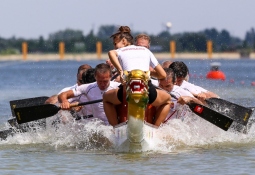Altogether there are 64 canoeing quotas available for the 2018 Youth Olympic Games in Buenos Aires – 32 men and 32 women.
So how do you earn one?
THE POINTS
Firstly an athlete needs to compete in both events – the head-to-head sprint, and the head-to-head obstacle. Both events will be contested on flat water, but the obstacle event will include a compulsory eskimo roll (where an athlete deliberately rolls their boat over in the water).
The athlete will earn points depending on where they finish in each event. The higher they finish, the less points they get.
So for example, the athlete who finishes second will get two points, while the competitor who comes in 74th will get 74 points.
The athlete’s points from both events will be added together, and the total will determine their final overall ranking.
For example: If athlete A from Tunisia finishes third in the sprint, and 15th in the obstacle course, they will have a total of 18 points.
But the athlete who finishes first will get zero points..
THE RACES
Both the sprint and the obstacle races are head-to-head events. In the heats and the repechage, times will determine who progresses to the next round. The five fastest boats from the heats will go straight through to the quarter finals, while the next 30 boats progress to the repechage.
The three fastest boats in the repechage will then progress to the quarter finals.
From the quarter finals to the final the winner will be determined by first across the line. In the quarters, the fastest athlete will compete against the fifth fastest, the second fastest against the sixth fastest, and so on.
The semi-final match-ups will be determined by times; the fastest quarter-final winner will take on the third fastest QF winner, and the second-fastest winner will take on the fourth fastest.
You can view an animated version of the race courses here.
CONTINENT QUOTAS
It’s important to remember the first 32 athletes will not automatically qualify for Buenos Aires. Continents have been allocated quotas for each event. For example, there are six positions available for European boats in the women’s K1, two for Africa, three for Asia, three for America and one for Oceania.
And each country can only qualify one boat. So if, for example, France finish first and second in the women’s K1, only one quota place will go to France.
So how does this work? Let’s imagine the final standings in the women’s K1 goes like this; the qualified boats have been highlighted.
1. France (Europe)
2. France
3. Germany (Europe)
4. Spain (Europe)
5. CzechRepublic (Europe)
6. Spain
7. Hungary (Europe)
8. Hungary
9. New Zealand (Oceania)
10. Australia
11. Kenya (Africa)
12. Canada (America)
13. Brazil (America)
14. New Zealand
15. Portugal (Europe)
16. Thailand (Asia)
17. Japan (Asia)
18. Japan
19. Sri Lanka (Asia)
20. China
21. Mexico (America)
22. Algeria (Africa)
It’s also important to remember the quota is allocated to a country, not the athlete. The final decision on which athlete competes in Buenos Aires will be made by the country’s National Olympic Committee.
Any athlete who qualifies in, for example, the K1, will also be able to compete in the C1 at the YOG – but they first have to prove to a judging panel that they are competent in the discipline for which they did not directly qualify.
The full breakdown of quota places available per event, per country, can be found here

